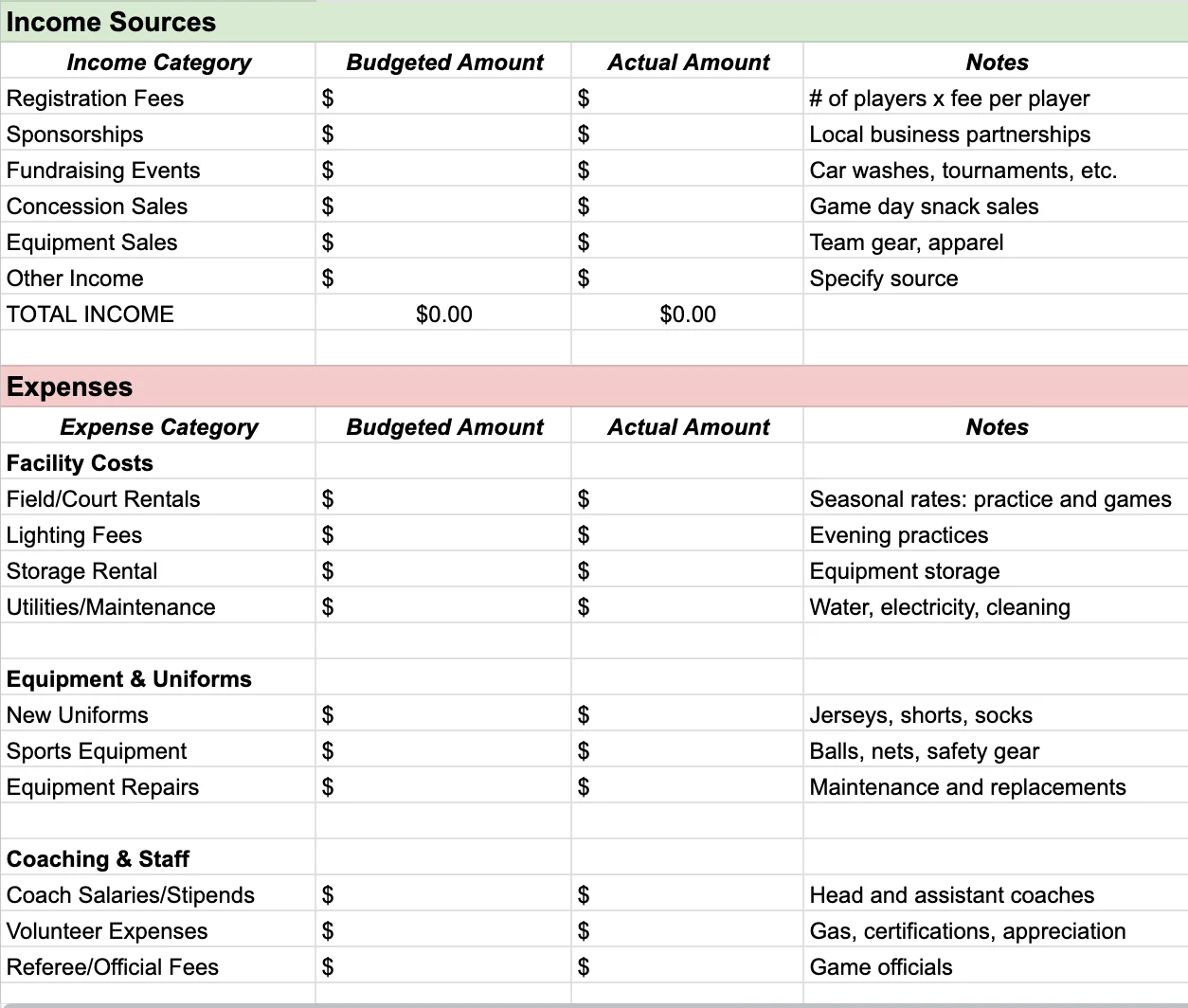How To Budget for Your Youth Sports Club: Free Template + Step-by-Step Guide
Sierra Swigert Last updated: August 4, 2025


Running a youth sports club is rewarding, but there’s one catch: the finances. It’s easy to lose track of where your money is going, especially when you’re in the heat of the season.
While your finances are a part of the business plan, make sure to include as many details as possible in your budget. Why? A well-planned budget keeps your club running smoothly, so you aren’t dealing with zero balances mid-season. And you don’t have to be a finance whiz to create an effective annual budget — you just need the right template.
Once you’re tracking every dollar, you can focus on giving kids and parents the memorable youth sports experience they signed up for.

Key expenses to include in your sports club budget
Youth sports teams have some pretty predictable costs, but other sneaky expenses can catch you off guard if you’re not ready for them.
Here’s what you need to account for:
Facility costs and rentals
Facility expenses are often your biggest budget line item, so get the numbers locked down early. Field or court rentals are the big-ticket items, but watch out for the extras like lighting fees for evening practices, cleaning deposits, and storage costs. If you’re responsible for utilities, you’ll also want to add in those expenditures.
Equipment and uniforms
What happens when equipment breaks or kids show up in mismatched gear? These expenses can drain your wallet. Budget for the obvious stuff like new gear, but also set aside money for repairs, maintenance, and any random replacements that pop up.
You can usually expect that a parent will forget to return their child’s jersey or that a player will outgrow their equipment. That’s why it never hurts to budget for 10–15% more than you think you’ll need for equipment surprises.
Coaching and staff costs
Your coaches and staff are the heart of your club, so make sure you budget fairly for their time and talent. This might mean coach salaries, training stipends, or even volunteer coach expenses like travel for away games or coaching certification fees.
Don’t forget about your other key people: trainers, referees, and the admin volunteers who keep everything from falling apart. Budget for appreciation events or small thank-you gifts. A little recognition can go a long way in keeping good people around.
League fees and insurance
These aren’t the fun expenses, but they’re important for running a legitimate, protected program. League registration fees get you into the competitions that get your kids most excited, while liability insurance protects your club if something goes wrong.
This isn’t the place to cut corners. Most leagues require proof of insurance before you can even register. Shop around for rates and make sure you’re getting the best coverage for your activities and players. Since these costs are annual, include them in your yearly budget spreadsheet from day one.
Marketing and promotion
Getting the word out about your club doesn’t have to break the bank. Budget for things like flyers and social media ads, where you’ll get the most value. Keep your website updated with current info and registration details — this is where most people go to learn more about your club.
Think local when it comes to partnerships. Consider sponsoring a booth at a community event or partnering with schools to bring in new families. Even a simple yard sign during registration season or branded gear for coaches can boost your visibility.
Event and travel costs
Tournament fees and travel expenses can eat up your budget quickly if you’re not careful. Let’s say you have a youth travel baseball team. For every weekend trip, you’re looking at $500 to $1,500 for travel and lodging.
Start by mapping out your season — which tournaments are top on your priority list — then consider entry fees, transportation, and lodging. If families are handling their own travel, you might still need to budget for team meals or coach accommodations.
And don’t forget the smaller costs like gas money for transporting equipment or venue parking fees. Planning ahead can prevent major headaches later.
Contingency or emergency fund
Stuff happens, whether that’s equipment breaking at the worst possible moment or suddenly needing extra insurance for a special event. That 10–15% safety net we mentioned earlier? You’ll need it for things like this.
If you’re lucky, you won’t have to spend this money. But if life throws you a literal curveball, you have a buffer to handle the surprises without hosting a last-minute fundraiser or asking families for contributions.
How to build your sports club budget
Now that you know what expenses to look out for, you can put it all together in a working budget. Your budget doesn’t have to be overly sophisticated — the goal is to create a practical tool that helps you track your money and make smart decisions throughout the season.
Follow this step-by-step process to make your budget plan feel painless.
1. Review last year’s finances (if available)
Before you plan ahead, find out where your money went last season. Pull out those bank statements, receipts, and any financial records you can find, even if they’re scattered across different folders or on volunteers’ phones. This will give you real numbers to work with instead of guessing.
Your focus here shouldn’t be on judging past financial decisions, but rather on learning from them. Look for patterns: Did you overspend on equipment? Were facility costs higher than you expected? Could you have added a few more sponsorships?
2. Estimate your income
Next, find out how much money you’ll have to work with. Start with your most reliable income sources. For most clubs, these are membership fees. Multiply your expected number of players by your registration fees. Then look at your other revenue streams, like local business sponsorships, fundraising activities like car washes, or tournaments and concession sales.
Be realistic with your estimate. It’s better to underestimate than to come up short mid-season. For example, if last year’s fundraiser brought in $2,500, budget $2,000 this year to give yourself some cushion.
3. Outline your expenses
Now for the nitty-gritty: listing everything your team will need to spend money on this season. It might sound like a lot, but work through each category we talked about and plug in realistic numbers.
Outline fixed costs like league fees and insurance since those numbers are usually set, then tackle variable costs like equipment and travel costs. Most teams also have smaller line-item costs like team photos, end-of-season awards, and coach appreciation gifts.
Remember, it’s easier to remove an expense you don’t end up needing than it is to find money you didn’t budget for.
4. Use sports club management software to organize it all
Once you’ve figured out your numbers, don’t let them live in a random Excel spreadsheet that only one person can access. Sports club management software like Jersey Watch can help you keep everything organized and accessible. These platforms let you track income as it comes in while centralizing your expense records.
And when it’s time to hand over responsibilities to the next volunteer, everything’s already organized and easy to transfer. You won’t have to spend your time digging through email chains or trying to remember which board member has the real budget worksheet.
5. Monitor and adjust regularly
Your budget isn’t a one-and-done document. It’s a tool you should revisit outside of your budgeting process. Set up monthly or quarterly budget reviews to see how you’re tracking against your projections. You might find that your equipment fund is getting drained faster than you expected or your fundraising efforts are going gangbusters.
When you spot trends early, you can make adjustments early to prevent small issues from turning into big problems. You don’t have to stress over every dollar, but it is important to stay aware of your finances so you can make adjustments as needed.
Budget template to use for youth clubs
We’ve created a simple budget template designed for youth sports clubs. This table includes all the key expense categories we covered, plus space to track your income sources and progress throughout the season.
You can view the full template in a spreadsheet and make a copy for yourself: Download a Free Sports Club Budget Template

Manage your youth sports club easily with Jersey Watch
Not everyone loves budgeting for their youth sports club. But it doesn’t have to be your most dreaded task either. By following these steps — reviewing last year’s finances, estimating income, outlining expenses, using management software, and monitoring regularly — you’ll have the foundation your club needs to thrive.
Jersey Watch makes the entire process easier by helping you track income as it comes in and keeping it organized in one place. With clearer, more simplified financial management, you can enjoy every action-packed season without fearing the finances.
Get started with Jersey Watch today and take control of your club’s finances!